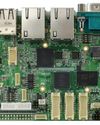Denemek ALTIN - Özgür
Understanding MCU Timing
Circuit Cellar
|December 2025
What Actually Happens Inside That Chip?

What happens between your source code and the low-level machine code in your MCU is not usually obvious. In this article, Stuart investigates that disconnect.
Most of the time when we work with an MCU, we design the hardware, write and debug the software, and then we're done. Long ago, when I started out in this industry, it wasn't uncommon to use assembly language. I wrote assembly code for both MCU and DSP designs. But it didn't take long for languages like C and C++ to replace assembly. Higher level languages provide a lot of benefits: type checking, memory management, simpler code, code that's easier to maintain, and at least some abstraction from the underlying hardware. There are C and C++ compilers for most MCUs, both free tools from the manufacturers and commercially available tools. But one thing you give up with a higher-level language is a connection between the source code and the related timing.
When I was in college, many years ago, I took about every programming course available, including COBOL (that tells you how far back that was, assuming you're old enough to even know what COBOL was). We were programming on an IBM 360 mainframe computer, and I discovered there was a compiler switch that would show you the underlying assembly code generated by the compiler. The printout (no interactive terminals, at least not for this class) would show you the line of COBOL code and then the underlying assembler statements. COBOL provides a high level of abstraction, so a single COBOL statement can produce many lines of assembly code. I turned in an assignment that way; what would have been a single page of COBOL statements was many pages of assembly code. The grader gave me 100 on the assignment but added a note: “Don’t ever do this again.” At that age, I thought it was humorous. The grader obviously did not.
Bu hikaye Circuit Cellar dergisinin December 2025 baskısından alınmıştır.
Binlerce özenle seçilmiş premium hikayeye ve 9.000'den fazla dergi ve gazeteye erişmek için Magzter GOLD'a abone olun.
Zaten abone misiniz? Oturum aç
Circuit Cellar'den DAHA FAZLA HİKAYE
Circuit Cellar
Alif Semiconductor Elevates Generative AI at the Edge with New Support for ExecuTorch Runtime in Its Ensemble MCUs
Alif Semiconductor, the leading global supplier of secure, connected, power efficient Artificial Intelligence and Machine Learning (AI/ML) microcontrollers (MCUs) and fusion processors, announced that developers can now use the ExecuTorch Runtime, a quantization extension of the popular PyTorch ML framework, for AI applications built to run on its Ensemble E4/E6/E8 series of MCUs and fusion processors.
1 min
December 2025

Circuit Cellar
Encrypted MQTT Protocol for Critical Sectors
Mechanisms, Challenges, and Best Practices
3 mins
December 2025

Circuit Cellar
Datasheet: Small Size, Big Power
Smaller Microcontrollers Bring New Possibilities
9 mins
December 2025

Circuit Cellar
Analog Devices Launches ADI Power Studio and New Web-Based Tools
Analog Devices, Inc. (ADI), a global semiconductor leader, announced the launch of ADI Power Studio, a comprehensive family of products that offers advanced modeling, component recommendations, and efficiency analysis with simulation.
1 mins
December 2025

Circuit Cellar
Compact IBR300 2.5" SBC Powered by NXP i.MX 93 from IBASE
IBASE Technology, Inc., a leading provider of rugged embedded computing platforms, announced the release of the IBR300, a 2.5\" RISC-based single board computer (SBC) powered by the NXP i.MX 93 processor with dualcore ARM Cortex-A55 (up to 1.7GHz) and a Cortex-M33 MCU.
1 min
December 2025

Circuit Cellar
Sensors in the Spotlight
The Next Decade of Embedded Sensor Systems
12 mins
December 2025

Circuit Cellar
Bob's Wrap Up
In Bob's last article with Circuit Cellar, he attempts to wrap up a career of more than 50 years as an embedded systems engineer and 14 years with Circuit Cellar. He looks at each of his 58 articles by category and provides some recommendations for his fellow engineers.
7 mins
December 2025

Circuit Cellar
Designing Embedded Software Architectures That Last
I've reviewed hundreds of firmware projects over the years, and one thing always stands out: the most successful projects have a clear, deliberate architecture.
10 mins
December 2025
Circuit Cellar
Broadcom Introduces Industry's First Wi-Fi 8 Silicon Ecosystem Powering the AI Era
Broadcom, Inc. unveiled the first Wi-Fi 8 silicon solutions for broadband wireless, targeting residential gateways, enterprise access points, and smart mobile clients.
1 mins
December 2025

Circuit Cellar
GD32 MCU Family Expands High-Performance Portfolio with New GD32F503/505 Series MCU
GigaDevice, a leading semiconductor company specializing in Flash memory, 32-bit microcontrollers (MCUs), sensors, and analog products, announced the official launch of the GD32F503/505 series of high-performance 32-bit MCUs, expanding its product range based on the ARM Cortex-M33 core.
1 mins
December 2025
Listen
Translate
Change font size

